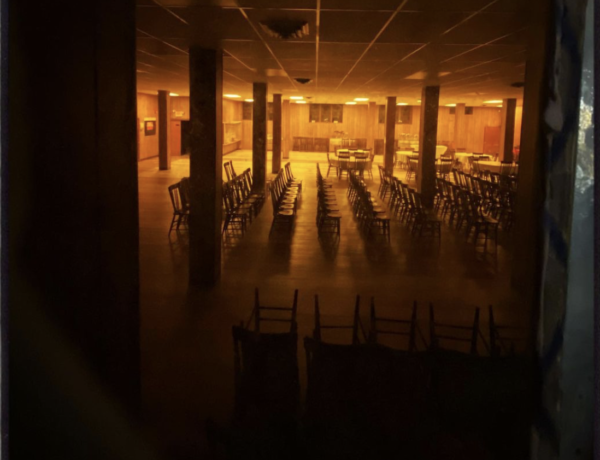By Timothy Pauley
Over the past three or four decades, prison has evolved into big business. Where once a state would construct one or two massive facilities (partially with prisoner labor) to house their most dangerous criminals, now most states have an ever-increasing collection of pre-fab prisons that have almost completely replaced these original structures. This process has seen an infrequent public works project evolve into a massive pork-barrel handout, diverting staggering amounts of tax dollars to private companies, often to companies from other states.
Most of the older prisons were towering concrete and steel structures designed to last hundreds of years. The living units were nothing but concrete rooms lined up next to one another, sometimes stretching up to a quarter mile long. These “tiers” were then stacked on top of each other up to five stories high. They were finished off by sealing the front with heavy steel bars. A typical cellblock could hold several hundred prisoners.
These cellblocks are the epitome of the “no frills” prison any savvy politician will quickly tout the merits of when asked about his “tough on crime” stance. Why is it then that these same politicians are steadily voting to fund the demolition of these superstructures and replace them with modern human warehouses at costs reaching several hundred million dollars each? Why, for example, would these career “advocates of the people” squander significant portions of their law enforcement budget to construct a kinder, gentler prison where prisoners have relatively quiet two man rooms with keys to their own doors? Why would these people strive to make the prison experience softer and less frightening for newcomers to the prison system? How could taking the fear out of the prison experience possibly help prevent crime and make our streets safer?
These questions will never be answered honestly in public. The best any politician worth his slush fund could hope to do is obscure the issue and sidestep these hard questions. That is, assuming anyone ever asked, which typically never happens. But in the end this discussion would likely just deteriorate into a veiled threat to unleash violent criminals onto society if taxpayers do not pony up, in the form of higher taxes, the ransom for yet another new prison.
Decades ago there was a national scandal when a reporter discovered the military was purchasing toilet seats for some of their aircraft at over four-hundred dollars each. A huge public outcry quickly ensued as citizens became outraged their tax dollars were being carelessly squandered. The new prison program has been going on for decades now and has touched nearly every corner of this country, yet the mainstream media appear oblivious. This is the toilet seat scandal on steroids.
On the surface, one might think liberals were pushing this agenda. After all, a kinder gentler prison smacks of the so-called “hug a thug” mentality. Upon closer examination. however, facts might reveal such is not the case. Typically liberals are pushing for prison funding to be directed into education programs, like college and vocational programs; things with a proven impact on rehabilitation. While such programs might raise the public’s ire, at least they have a measurable track record of reducing recidivism.
No, the politicians pushing the prison construction agenda are frequently conservatives.
To make sense of this apparent contradiction, one must understand the political structure of the corrections community. In this realm the lines are not delineated as in broader society, that being Democrats versus Republicans. In corrections it is rehabilitation versus retribution. This is the party system as it relates to prison policy.
On one hand you have the rehabilitation camp. They believe society can best cope with the crime problem by fixing what was wrong with a person that motivated them to commit crimes in the first place. With the obvious exception of sexual deviants, for whom there is no comprehensible motivating factor, most crimes are perpetrated either to get money or to resolve a conflict. The rehabilitation model addresses these problems by trying to prepare prisoners to be financially viable upon release, educating them and perhaps teaching them a marketable trade. Attention is also paid to teaching problem solving mechanisms and conflict resolution skills other than violence. When those with this approach are in control of the corrections budget, discretionary spending is prioritized toward these areas.
The retribution approach, on the other hand, operates on the premise that prisoners need to be punished. Not just punished by sending them to prison, but punishing continually throughout the period of incarceration. A good example of retribution based discretionary spending can be found in the “control unit” or “Supermax” prisons that have been erected across the country over the past thirty years.
The functional purpose of a control unit is to replace segregation or “the hole.” Nearly every prison has always had a segregation unit. It is essentially a jail within the prison and is used for three purposes. One is for punishment of prisoners who break the rules. Where a person in the community might have to serve thirty days in jail if they were convicted of a minor crime, a prisoner has to serve thirty days in segregation. The second purpose is when there is reason to believe a prisoner has become a threat to the safety of either himself or someone else, he is placed in segregation until such time as the threat is determined to no longer exist. The third reason is protective custody. If a prisoner reports that he believes he is in danger, he is placed in segregation until such time as the danger no longer exists or authorities can arrange a place to transfer him away from the threat.
For whichever of these reasons the segregation cell is being used, the atmosphere is the same. The prisoner is placed in a cell (usually by themselves), kept there around the clock, including meals, and only permitted out of their cell for one hour a day, where they are permitted to recreate alone and take a shower. The only possessions segregation prisoners are typically permitted consist of a small amount of writing materials (a pen, paper, a few envelopes, and an address book), one set of clothing (usually prison issue coveralls), underwear, a set of prison issue plastic slippers, and perhaps a library book or two. In the case of disciplinary problems, this deprivation is perhaps warranted, and for the threat assessments, this is justified because that situation is supposed to be temporary.
In the past, segregation beds were reserved for only the most severe rule violations. When indeterminate sentencing was in place, prisoners had huge incentives to manage their behavior properly or risk serving significantly longer portions of their sentences before being considered for parole. A prisoner would be sentenced to ten years, for example, but if they made a diligent effort to stay out of trouble and rehabilitate themselves they might only serve half that before being conditionally released on parole. This incentive significantly reduced the need for expensive segregation bed space.
With the advent of determinate sentences (predetermined terms of confinement) in the seventies and eighties, however, that incentive was virtually removed. With no chance for discretionary release, vastly increased sentences, and steadily decreasing good time allowances, there became very little incentive for the typical prisoner to comply with prison rules. The predictable response was that many prisoners quickly developed a habit of ignoring the rules, which resulted in a push to make stricter rules, further increasing the need for control unit beds. This situation opened the door for an astute prison salesman to make a career selling segregation prisons across the country. That is exactly what happened.
One of the main allies of the prison salesman has been guards unions. As the number of prison employees increased, these unions became more powerful. They now exert considerable influence over policies and logistical decisions. Control units have a staff to prisoner ratio that is typically two to three times or higher than that of a regular facility. More control units equal more prison guards. It is not difficult to understand why these unions are enamored with the proliferation of such labor-intensive new facilities.
The state of Washington is a good example. They switched to determinate sentencing in the early eighties. In the years that followed they purchased two Intensive Management Unit (control unit or “Supermax”) prisons almost immediately. As rehabilitation faded from the picture, Washington was soon purchasing a new prison every couple of years, including over a half dozen control units. In fact, since their determinate sentencing system was passed by the legislature, they have undertaken over seventeen major prison expansions. Predictably, whenever alternate approaches were proposed, the guards union vigorously opposed them.
Much of this expansion was, in fact, lobbied for by the powerful guards union, the Teamsters. High paying jobs with full benefits for unskilled, uneducated workers are very rare outside of corrections. The guards union was quick to funnel massive amounts of money into the perpetual lobbying effort to fund prison expansion. This included any laws that might result in higher prison populations such as longer sentences, lower good time allowances, mandatory sentencing, and more strict laws. Any time legislation was discussed to curtail the human warehousing project, the guards union would parade a series of “corrections professionals” before the state legislature and the media who would employ scare tactics to intimidate lawmakers into furthering the union agenda; perpetual prison expansion. Their self-proclaimed expertise was rarely questioned.
When a real estate broker sells a building they typically earn a percentage of the purchase price. What might the commission on a two-hundred million dollar prison look like? This is big business and there is clearly a vested interest in perpetuating this unprecedented prison expansion. Why devote money to the rehabilitation of criminals, and risk a reduction in prison population, when there is so much money to be made?
Unfortunately the money to be made is not earned in the traditional sense. This money is simply redistributed wealth. Taking money from uninformed citizens to fund an ever-expanding government and to line the pockets of an overpaid, unskilled workforce would be bad enough in and of itself. When we consider the fact that in many states this prison expansion is at the expense of gutting education budgets or eliminating services for the most vulnerable citizens, it becomes egregious. Yet these unscrupulous “experts” continue to use fear mongering to divert a perpetually increasing portion of the tax revenue into this warehousing effort.
When funding for a new prison seems in jeopardy, the guards unions and the media are quick to display a thirty-year-old photo of some angry young man who did something terrible decades ago. Even though he is now a broken down old man, they will imply that if funding for their project is not allotted, this menace to society could be unleashed on the community at any moment.
The reality of that situation is older prisoners who committed serious crimes decades ago are the least likely to pose a threat to anyone. Not only is there a strong probability they have aged out of crime but they have also become far more expensive to incarcerate due to age related medical expenses. A compelling case could be made that it would be prudent to release them in their fifties so they could fund their own retirement instead of keeping them until they are virtually guaranteed to be a ward of the state forever.
But these facts are never part of the prison expansion debate. That is because it really is not a debate at all. Anyone who stands up to the guards union is immediately vilified as if they were a criminal or lunatic.
So when you hear a politician giving an impassioned speech on how they want to get tough on crime, think about the hidden agenda because there definitely is one. Washington State replaced a system designed to make a distinction between prisoners society was still angry with and those they were truly afraid of (typically putting the former on parole) with a system that removed the quality control component from the release process. From 1950 to 1980 the Washington prison population went from 3,000 to around 4,400. The next year, 1981, Washington passed the Sentencing Reform Act mandating determinate sentencing. Fast forward to 2010 where the prison population of that state stood at stood at over l8,000. To put those numbers in perspective, the prison population grew at over three times the rate of their general population during that time.
When trying to assess the effectiveness of the determinate sentencing system, both sides have their favorite statistics they are quick to recite. All we really need to do is ask one simple question. Does anybody really think the streets were any safer in 2010 than they were in 1980 (when drive by shootings and roving bands of meth addicts stealing anything that isn’t nailed down were unheard of)? If we cannot answer a definitive yes to that question, then perhaps it is time to go back to the system that not only worked better, but didn’t fund a luxurious early retirement for dozens of unscrupulous prison salesmen and lobbyists at the expense of misinformed taxpayers.
Timothy Pauley 273053 A316
Washington State Reformatory Unit
P.O. Box 777
Monroe, WA 98272-0777
Click here to view a video of Tim reading one of his essays






No Comments
piscator
March 8, 2018 at 1:49 amTim,
This is a brilliantly reasoned essay! I've never read a better penned editorial. First rate!
I don't have any firsthand experience of prisons, but I do understand effective discipline.
In my manufacturing workplace we taught managers that 'discipline' was ALWAYS impersonal, directed toward keeping the wheels turning, and NEVER about personalities. On those rare occasions when a young, new, manager gave in to the temptation of pushing his new-found weight around, he was strongly corrected. We didn't tolerate ego driven, personal agendas anywhere.
Actually, we had very few disciplinary problems as evidenced by the fact that most of us stayed with the company 10, 20, 30, and even 40 years! Among other reasons, I think this was due to our absolute commitment to fairness.
I mention this only to express my shock that the prison system doesn't operate this way. I had no idea how 'penitential' the penal system really is. Retributive justice doesn't work and is an utter waste of both human and capital resources!
I would add though, concerning your story, "The Crow" — both the guard and Tom the tortilla thrower are at fault. The policies of my company would have put both parties on disciplinary leave. Unless there were some egregious moral breach, we wouldn't have spent much (if any) time trying to establish who was 'more at fault.'
The basis for this is my belief that no-one has the right to disrupt the peace and livelihood of the rest of the crew. Petty squabbles can't be tolerated. That's what I mean by scrupulous fairness.
But how do you apply that to a prison system that contains a fair share of 'trouble-makers' among both the inmates and the guards? I've become seriously perplexed by that question.
Thanks again for your thought provoking article.
Sincerely, piscator